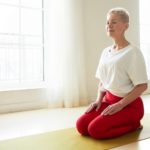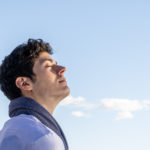
Rachael Cooper
Certified yoga instructor (Vinyasa and Hatha Yoga), CYT 200 teacher training certificate
Note — The article was checked and updated June 2023.
The ancient yoga practice dates back thousands of years and was brought to us through the Vedas, ancient Hindu scriptures.
The practice of yoga combines
- Physical
- Mental
- Spiritual aspects.
When we learn the practice of yoga, we begin to discipline the body, mind, intelligence and consciousness to create a life of contentment.
Yoga does not just change the way we see things, it transforms the person who sees.
― B.K.S Iyengar
Let us, therefore, see how yoga started and also see if we can be transformed as well – to a better version of ourselves.
What does the word "Yoga" mean?
The word Yoga comes from the Sanskrit word Yuj, meaning
- “to yoke”
- “to join”
- “to unite”
In Indian philosophy, to perform the practice of yoga, is to yoke, join or unite the body-mind with the spirit.
It is the intention of the person adopting the yoga lifestyle to unify the mind with the spirit and to overcome dis-ease and suffering.
Yoga can help to achieve freedom and harmony in all walks of life
Researchers have found evidence of yoga in India in circa 3000 BC. Archeological findings depicting meditative postures were found in the Indus Saraswati Valley, however it’s not until 1500 BC that we first see the mention of the word yoga. This was found in the sacred Hindu texts called The Rigveda.[1]
The Rigveda is written in Sanskrit where we can see yoga written in three scriptures:
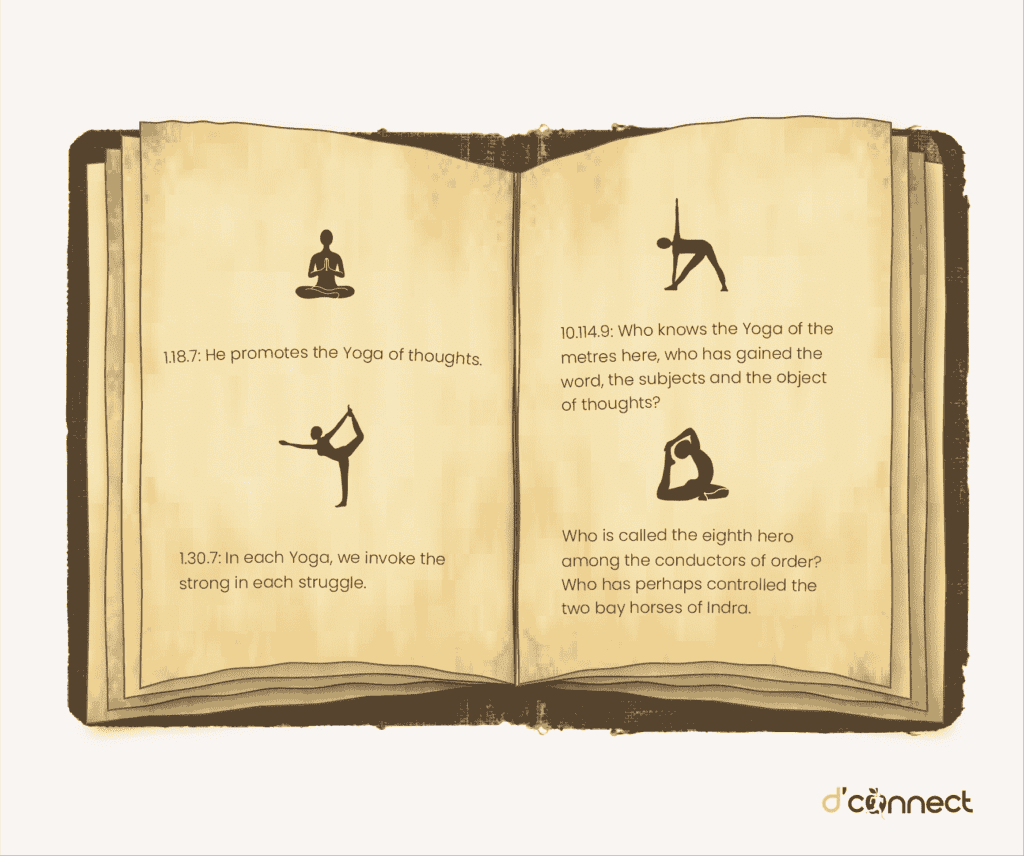
These texts suggest that yoga is an inward spiritual journey to harmonise our intellect, mind and emotions.[2]
When did yoga as a practice first start?
Yoga is an ancient practice that started in India, however we do not have substantial knowledge of when people first started the practice of yoga.
It is said that Lord Shiva, one of the most important Gods in Hinduism. He was the first Yogi and is worshipped as the “Conqueror of death” and the “Giver of joy”.[3]
How has yoga evolved through time?
Yoga originates from Hindu traditions. Though yoga derives from religion, it is not a religion.
Yoga is an integral part of Buddhism, Vedanta and Jainism
As yoga has evolved throughout its 5000 years, different teachers have created different paths of the Yoga Journey but the ultimate goal has still remained – to achieve unity with the mind-body and spirit.
During its earlier years, yoga focused mainly on the meditative aspects while the asanas (postures) were secondary. The many great yogis that we see in the modern period have brought more focus towards the asanas.
From its ancient beginnings until now, yoga has taught its followers that we cannot stray away from hardships and challenges that happen in life, but to get through those times at ease.[3]
The evolution of yoga through different periods

Vedic yoga period
The Vedic yoga period relates to the four ancient and poetic Hindu texts, the Vedas, meaning ‘knowledge’. These are
- Rig Veda (where we see the first mention of yoga)
- Sama Veda
- Yajur Veda
- Atharva Veda
Veda texts are the oldest pieces of Sanskrit and Hindu literature and were written around 1500 BC – 500 BC.[4] It is thought that the Vedas were orally passed down prior to these years.
During the Vedic period, yoga was predominantly practised by the Barhmans (the Vedic priests), and Rishis (an enlightened person) who instructed a group of students in a supervised environment, close to nature and away from the distractions of busy townships.
The practice of yoga during the Vedic period consisted of rituals, sacrifices and ceremonies to expand the mind past its limitations.[3]
Pre-Classical yoga period
The Upanishads are a collection of about 200 Hindu texts, composed around 500 BC as a subcategory of the Vedas.
The Upanishads expanded on the Vedas to bring more clarity, and departed from the rituals of sacrifice and ceremonies. The Upanishads brought the journey of yoga inwards to the Self.
Here, we see the early uses of common yoga techniques that are still being used today, including
- Pranayama (breath control)
- Pratyahara (withdrawal of the senses)
- Dhyana (meditation)[5]
During the pre-classical period, Jnana and Karma yoga were introduced.
Jnana, meaning knowledge, can be said to be one of the hardest paths of yoga to reach contentment.
Karma yoga can be described as “doing your duty at your best, without involvement of ego or attachment.[6]
Classical yoga period
As yoga moved through different countries, Buddhism adopted yogic philosophies and we started to see Buddhist values intertwine with Hinduism.
Raja yoga became apparent in the classical period and holds many aspects of Buddhism.
Modern yoga mostly relates to the Classical period of yoga
The aspects of Classical yoga mainly come from Patanjali, the author of the The Yoga Sutras. The Yoga Sutras were written around 500 BC and hold similarities to Buddhist values.
The Yoga Sutras are a set of 196 Sanskrit verses expanding on the Upanishads and are used as a guide to direct us to a path of englightenment.
Patanjali defined yoga through eight stages, more commonly known as The Eight Limbs of Yoga.
- Yamas: External ethical disciplines
- Niyamas: Inner ethical observances
- Asana: Poses
- Pranayama: Breath Control
- Pratyahara: Sensory control and withdrawal
- Dharana: Concentration
- Dhyana: Meditation
- Samadhi: Enlightenment[3]
Post-Classical yoga period
Post-classical yoga brings more attention to asana (postures).
Here we start to see that yoga asana should be used as a powerful tool to promote good health by cleansing the body. This allows us to achieve contentment in the mind.
RELATED — Physical and psychological benefits of yoga
Many different asanas were developed to allow the whole physical body to become invigorated.[7]
Tantra yoga, a style of yoga developed around 500 CE became popular during this period. Tantra yoga brings emphasis on harmonising the energy (Chakras) in the body by performing
- Asana
- Meditation
- Mantras
- Mudras (hand gestures)
to achieve contentment.[8]
Hatha yoga is also prominent during the post-classical period. Hatha yoga reflects values of both Hinduism and Buddhism and The Eight Limbs of Yoga, as outlined by Patanjali.
Asanas practised in the Hatha are typically held for long periods to allow the practitioner to adjust into correct alignment and connect with every part of the physical body.[9]
Modern Yoga
The start of modern yoga brings us to the late 1800 where yoga began to make its presence in the West, notably by the Hindu Monk Swami Vivekanada.
A lot of modern yoga teachings are based on Patanjali’s Yoga Sutras as many yogis who brought yoga to the West often refer to the readings of Patanjali.
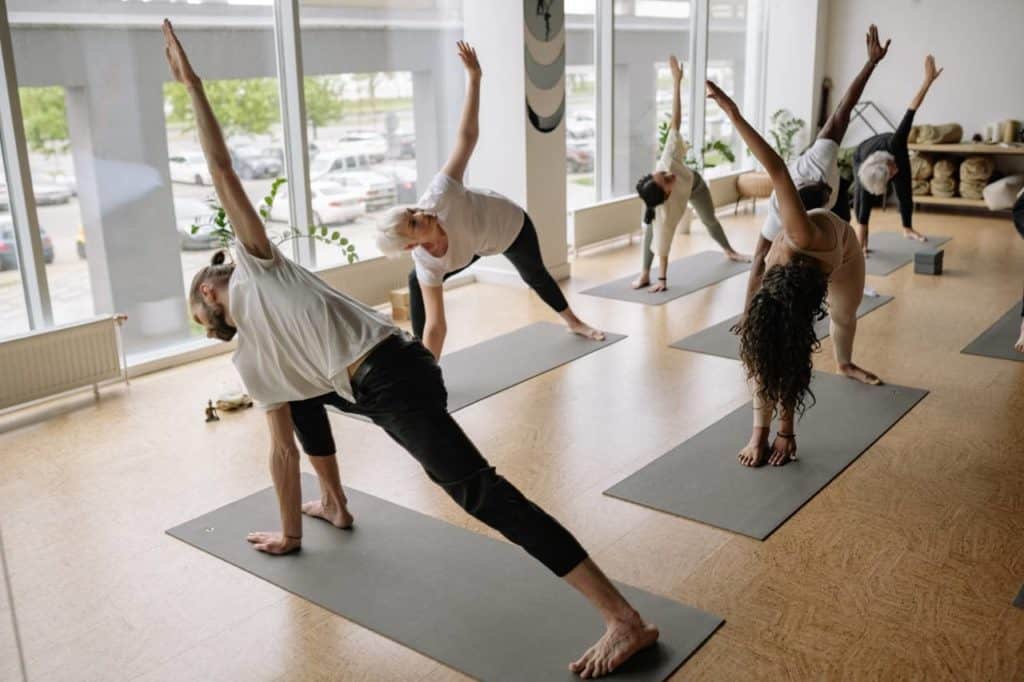
We begin to see a wide range of yoga schools introduced as well as dramatic changes in lifestyle, with women becoming a lot more involved.
We also start to see a shift away from only religious people practising yoga. Yoga masters started to cater yoga to individuals, by focusing on their capabilities and their reasons for desiring a Path of Yoga.[10]
Yoga and the East
The early teachings of yoga take us back around 5000 years. Yoga was passed down to its students orally, so it’s fairly difficult to identify the lineage during these early times.
However, in Hindu philosophy, it is believed that Lord Shiva, the creator of Yoga, passed on his words of Yoga to the Seven Sages.[1]
These Seven Sages are defined in the Vedic texts as the first yoga practitioners with the purpose to pass on the knowledge of yoga around the world.[11]
The Seven Sages travelled through Asia, the Middle East, North Africa and South America. Maha Rsi Agastya, one of the Seven Sages, notably travelled to Indonesia where he spread the teachings.
The philosophies of yoga have remained an integral part of religion in Indonesia, however it wasn’t until around the 1990s that Indonesian countries adopted the practice of yoga.[12]
The Buddha was born in the Himalayas around 500 BC, and has spent a lot of his early life in luxury. During his travels, however, he witnessed human suffering, old age, illness and death.
In search of finding the path of Nirvana (enlightenment), the Buddha left his home to study the art of meditation under Ālāra Kālāma and Uddaka Rāmaputta.[13]
After vigorous dedication to find Nirvana, the Buddha eventually reached his goal. He then decided to pass on the knowledge of meditation that was based on his 45-year journey and learning as he travelled on foot through North East India.[14]
Buddhism made its way to China via the Silk Road, however it wasn’t until Indra Devi opened her yoga school in Shanghai in 1939 when the practice of yoga started.[15]
As for other East Asian countries, Japan first started the practice when Bikram Choudhury opened Japan’s first yoga studio in the 1970s. In saying that, the popularity only picked up about 20 years ago when Okido was developed.
This practice combines asanas, meditation, and chanting.[16]
Yoga and the West
The journey of yoga arriving in the West started in the United States in the late 1800.
Swami Vivekananda, an Indian Monk, introduced Hindu and the philosophies of yoga to the United States in 1893 when he spoke at the World Parliament of Religions.[17]
His speech began with the line “Sisters and Brothers of America”, which shows his focus on love, acceptance and gratitude.[18]
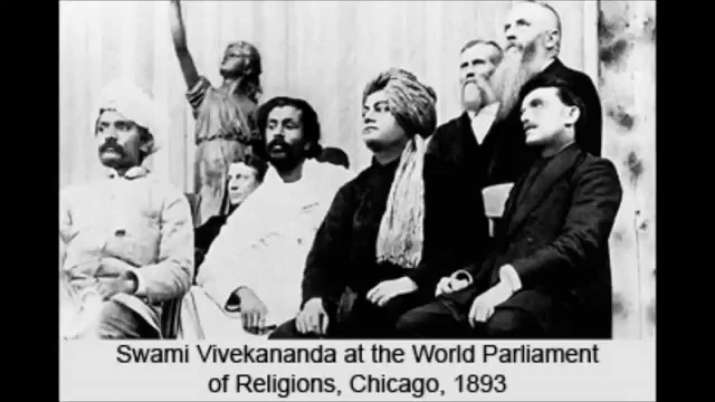
Swami Vivekananda spent two and a half years travelling around the United Stated and then went on to the United Kingdom where he addressed the four yoga paths (which he also discusses in his books)
- Bhakt Yogai: Love and devotion towards God
- Karma Yoga: Selfless actions
- Jnana Yoga: Liberation through self-knowledge
- Raja Yoga: Mind and body control.[19]
Great Yogis - individuals who shaped yoga through history
Swami Sivananda Saraswati (1887 - 1963)
Born in Tamil Nadu, South India, Swami Sivananda spent his life devoting to serve humanity. During his early years, Swami Sivananda excelled in academics which led him to become a medical doctor.
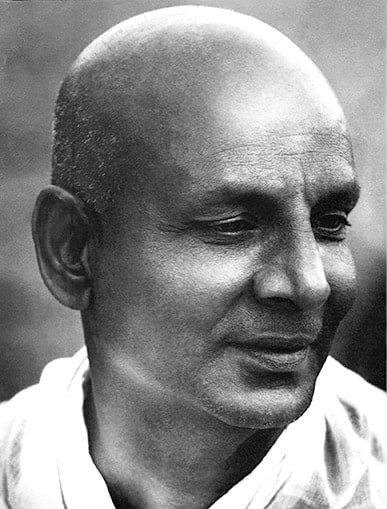
His generous nature and desire to provide service took him to Malaysia where he treated patients for free. After 10 years in Malaysia, Swami Sivananda journeyed to the Himalayas in 1924 to grow his spiritual journey under the Hindu Monk Swami Visvananda.
Eager to give to the community, in 1936, Swami Sivananda founded The Divine Life Society, a free organisation to provide yoga knowledge.
During his time, Swami Sivananda also wrote over 200 yoga books which are still widely used today.[20]
Put your heart, mind, intellect, and soul even to your smallest acts. This is the secret of success.
― Swami Sivananda
Tirumalai Krishnamacharya (1888 - 1989)
The creator of Vinyasa yoga and known as the Master and Father of Modern yoga, Krishnamacharya used methods of Ayurveda in yoga.
RELATED — Introduction to Ayurveda: Ancient medicinal healing methods

He also held great knowledge in Vedic philosophy, Sanskrit and music. Krishnamacharya taught yoga for 7 decades and for a number of years has studied yoga in the Himalayas near Nepal and Tibet.
His style of teaching typically reflects the style of Hatha yoga. He puts great emphasis on discipline in asana through correct alignment.[21]
Master the breath, let the self be in bliss, contemplate on the sublime within you.
― Krishnamacharya
B.K S. Iyengar (1918 - 2014)
Like many people today, B.K.S Iyengar began his practice of yoga for the physical benefits.
Iyengar suffered from many illnesses as a child including malaria, typhoid and tuberculosis and firmly believes that yoga saved his life.
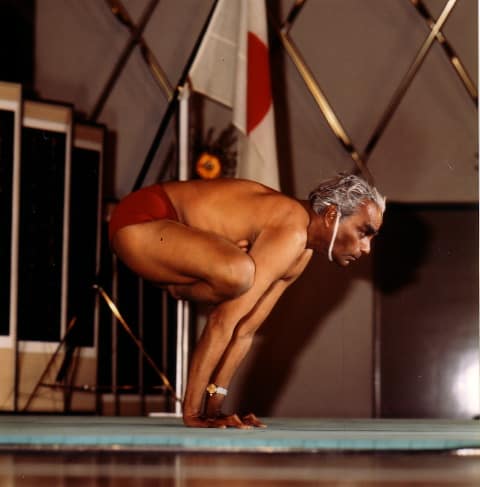
At the age of 14, Iyengar’s brother-in-law, Krishnamacharya, invited him to train at his yoga school to improve his poor health.
Iyengar practised only the asanas in his early years and would often demonstrate the asana in Krishnamacharya’s classes, but would gradually begin to incorporate all the aspects of yoga into his life, following the guidance of The Yoga Sutras of Patanjali.
Like other notable Yogis in the modern period, Iyengar also introduced yoga to the West and created Iyengar yoga, a yoga school which brings focus on alignment.
He also encouraged the use of props, such as blocks, chairs and bolsters, so that everyone was able to get the full potential of each asana, regardless of their physical capabilities.[22]

Yoga uses the body to discipline the mind and to reach the soul.
― B.K.S Iyengar
Indra Devi (1899 - 2002)
Indra Devi, or “The First Lady of Yoga”, was born as Eugenie Peterson in Latvia 1899.
Her yoga journey started when she took a trip to India in 1927, where she also worked as an actress, and became an Indian film star.
However, she was eager to learn yoga and went to the Master Yogi, Krishnamacharya. As it was still fairly uncommon for women to practice yoga during this time, Krishnamacharya was reluctant to take her on as a student. Eventually, he gave in and Indra Devi became a hardworking student.
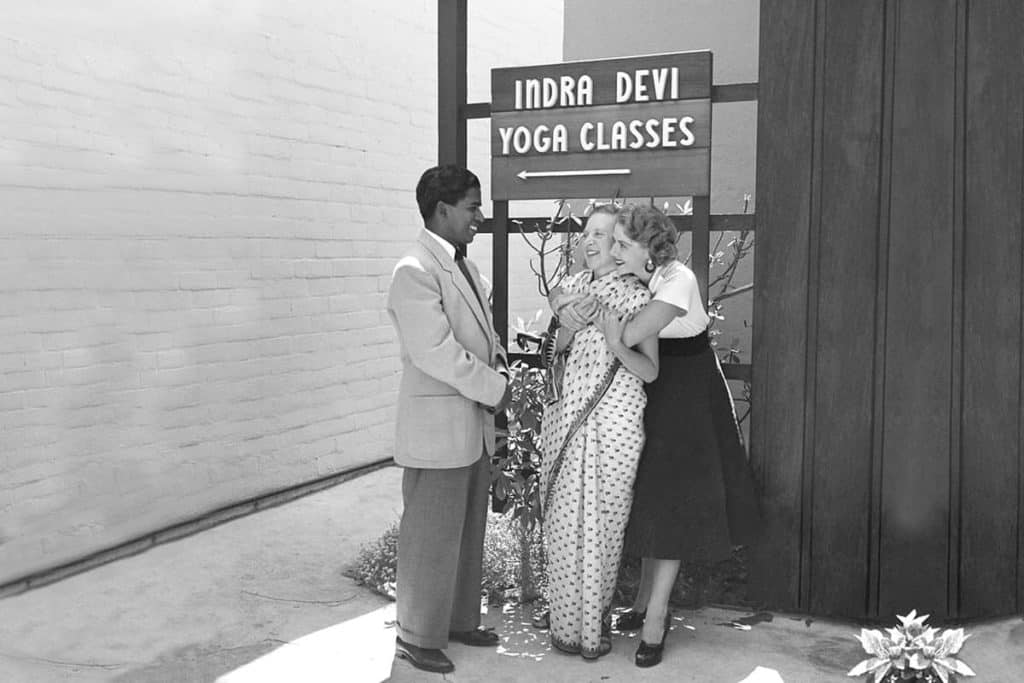
Her dedication to yoga took Indra to China where she worked as a yoga teacher and then made her way to America where she is known to have been the yoga teacher of famous Hollywood stars including Greta Garbo, Eva Garbor and Gloria Swanson.[23]
Yoga is a way to freedom. By its constant practice, we can free ourselves from fear, anguish and loneliness.
― Indra Devi
K Pattabhi Jois (1915 - 2009)
Jois began teaching yoga in Mysore, India in the 1930 after being a student for over 10 years under the yoga master Krishnamacharya.
He eventually went on to develop the popular yoga style, Ashtanga.[24]
Jois took many trips to America, the first in 1974 where he pushed the popularity of Ashtanga. He also made regular trips to Australia and New Zealand to share his knowledge and passion for yoga.[25]

Jois characteristics which created Ashtanga yoga contain ujjayi, which is a type of breathing with sound created from the back of the throat.
Ujjayi and the combination of asana, vinyasa (moving the breath with each asana), and bhanda (muscle contractions to direct the flow of energy to a certain area) gave Ashtanga the name “Power Yoga”.[26]
Yoga is for internal cleansing, not external exercising. Yoga means true self knowledge.
― K Pattabhi Jois
We hope that you liked the article on the beginnings of yoga. For more articles on yoga and meditation, please see our Relaxation page, where we talk about other methods and techniques on how to find balance in our daily lives.
Rachael first started practicing Hatha Yoga in 2014, and since 2017 has been focused on the Iyengar method, where she learned the importance of alignment and precision in asana, and creating yoga as a discipline.
Rachael is passionate about bringing the meaning of yoga and its practice into the community to create freedom from dis-ease in the body and mind. This is why she is continuously improving and evolving as a teacher and is currently in the process of completing CYT 300 teacher training certificate.
If you would like to know more about Racheal, please visit The Yoga Project. Rachael also holds free yoga classes at the local park as well as private indoor venue sessions.
References
(1) Dr. Ishwar V. Basavaraddi. Yoga: Its Origin, History and Development. Ministry of External Affairs, Government of India. 2015, 23 April. Retrieved from https://www.mea.gov.in/search-result.htm?25096/Yoga:_su_origen,_historia_y_desarrollo#:~:text=The%20word%20’Yoga’%20is%20derived,and%20body%2C%20Man%20%26%20Nature
(2) The History Of Yoga from the roots until now. Guru Of Love and Light. 2017, 6 November. Retrieved from https://www.markgiubarelli.com/yoga-teacher-training/the-history-of-yoga/#:%7E:text=Rigveda%2C%20in%2010.114.9%20%3A&text=who%20has%20perhaps%20controlled%20the,to%20start%20the%20spiritual%20journey
(3) P., & Shearer, A. The Yoga Sutras of Patanjali (Sacred Teachings). Harmony. 2002
(4) Mark, J. J. The Vedas. World History Encyclopaedia. 2022, 21 March. Retrieved from https://www.worldhistory.org/The_Vedas/
(5) The Art of Living. A Brief History Of Yoga | Art Of Living. Art of Living. India. Retrieved from https://www.artofliving.org/in-en/yoga/yoga-for-beginners/brief-history-yoga
(6) Jain, R. 2016, February 9. What is Karma Yoga & Its Principles | Arhanta Yoga Blog. Www.Arhantayoga.Org. 16, February 9. Retrieved from https://www.arhantayoga.org/blog/four-principles-of-karma-yoga/
(7) How Yoga Evolved. Bali Floating Leaf. 2019, February 4. Retrieved from https://balifloatingleaf.com/how-yoga-evolved/
(8) Tantra Yoga. Yogapedia.Com. Retrieved from https://www.yogapedia.com/definition/5034/tantra-yoga
(9) Newlyn, E. What is Hatha Yoga? Ekhart Yoga. 2021, April 5. Retrieved from https://www.ekhartyoga.com/articles/philosophy/what-is-hatha-yoga
(10) Michelis, D. E. A History of Modern Yoga: Patanjali and Western Esotericism. Continuum. 2005.
(11) Seven Sages. Yogapedia.Com. Retrieved from https://www.yogapedia.com/definition/7318/seven-sages
(12) Setiya, T. The Amazing History of Yoga in Bali. 2018, August 31. FactsofIndonesia.com. Retrieved from https://factsofindonesia.com/history-of-yoga-in-bali#:%7E:text=Yoga%20distribution%20from%20India%20to,of%20Kudungga%20in%20400%20BC
(13) Norman, G. The Origins of Buddhism. Asia Society. Retrieved from https://asiasociety.org/education/origins-buddhism
(14) Life of the Buddha: A spiritual journey. BBC Teach. 2019, November 8. Retrieved from https://www.bbc.co.uk/teach/life-of-the-buddha-a-spiritual-journey/zjf4y9q
(15) Indra Devi. Yogapedia.Com. Retrieved from https://www.yogapedia.com/definition/10595/indra-devi#:%7E:text=Yogapedia%20explains%20Indra%20Devi&text=In%201939%2C%20she%20conducted%20the,Soviet%20leadership%20to%20legalize%20yoga.
(16) Yoga Japan. Plyopic. 2018, February 28. Retrieved from https://plyopic.com/blogs/theyogablog/yoga-japan
(17) Life History & Teachings of Swami Vivekanand. Cultural India. Retrieved from https://www.culturalindia.net/reformers/vivekananda.html
(18) Swami Vivekananda and His 1893 Speech. The Art Institute of Chicago. Retrieved from https://www.artic.edu/swami-vivekananda-and-his-1893-speech
(19) Contribution of Swami Vivekananda In The Field Of Yoga – SHRF Yoga Bana. Shrf Yoga Bana. 2020, December 17. Retrieved from https://shrfyoga.com/blog/2020/12/17/contribution-of-swami-vivekananda-in-the-field-of-yoga/
(20) Swami Sivananda Saraswati. Google Arts & Culture. Retrieved from https://artsandculture.google.com/story/swami-sivananda-saraswati-sivananda-yoga-vedanta-centres-ashrams/rwVhKBVYlxFhKA?hl=en
(21) Hamsa, Y. H. H. Y. Krishnamacharya. Father of modern yoga. [Video]. YouTube. 2020, May 24. Retrieved from https://www.youtube.com/watch?v=YBARut5egYg&feature=youtu.be
(22) Iyengar, B. K. S., & Menuhin, Y. Light on Yoga: The Bible of Modern Yoga (Revised ed.). Schocken. 1979.
(23) Skinner, M. Indra Devi: The First Lady of Yoga. The YogaLondon Blog. 2018, December 16.
(24) Bajaj, V. Krishna Pattabhi Jois, Leading Expert in Yoga, Dies at 93. The New York Times. 2009, May 22. Retrieved from https://www.nytimes.com/2009/05/21/world/asia/21jois.html
(25) Auckland Yoga Academy. 2017, June 30. Sri K. Pattabhi Jois. 2017, June 30. Retrieved from https://yoga.co.nz/about/teachers/lineage/sri-k-pattabhi-jois/
(26) History of Ashtanga Yoga. Amayu Yoga. Retrieved from https://amayuyoga.com/history-of-ashtanga-yoga/




